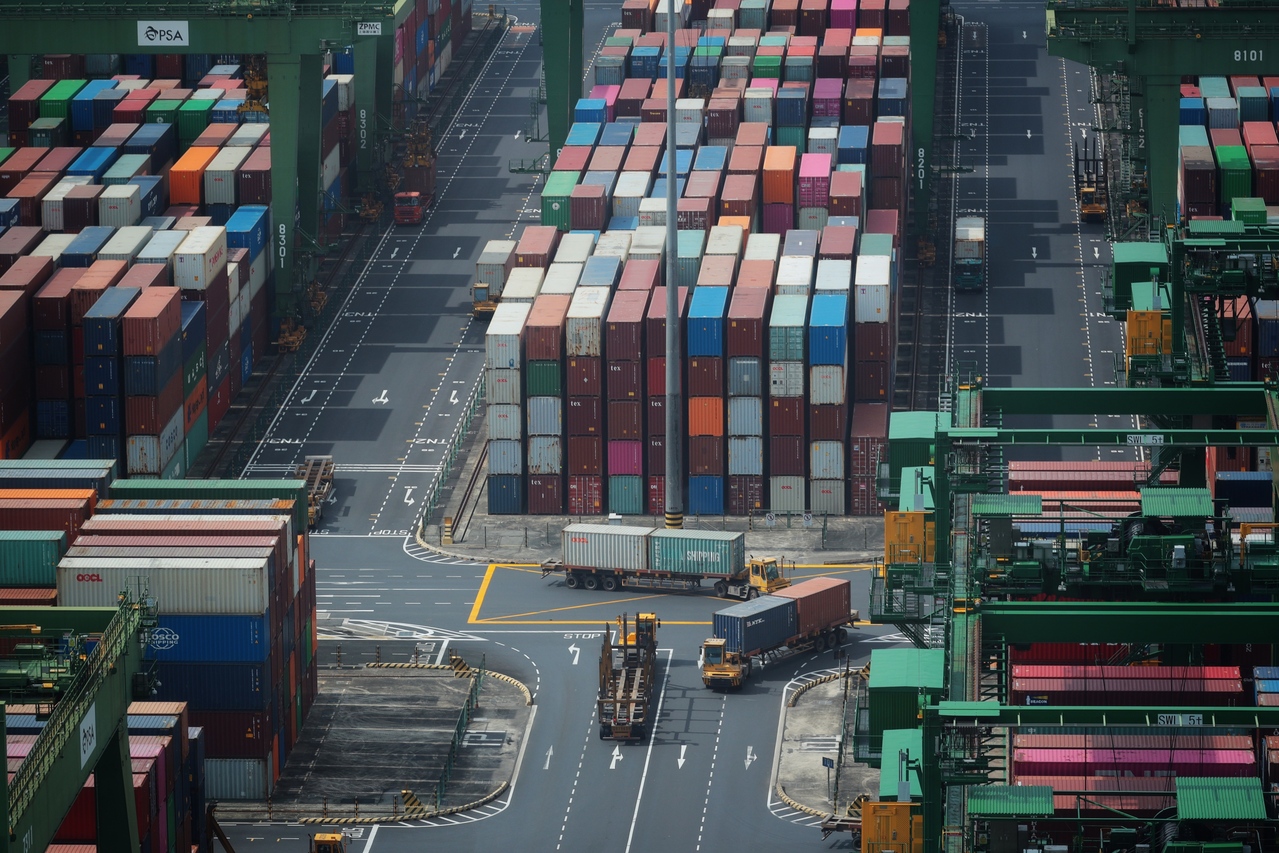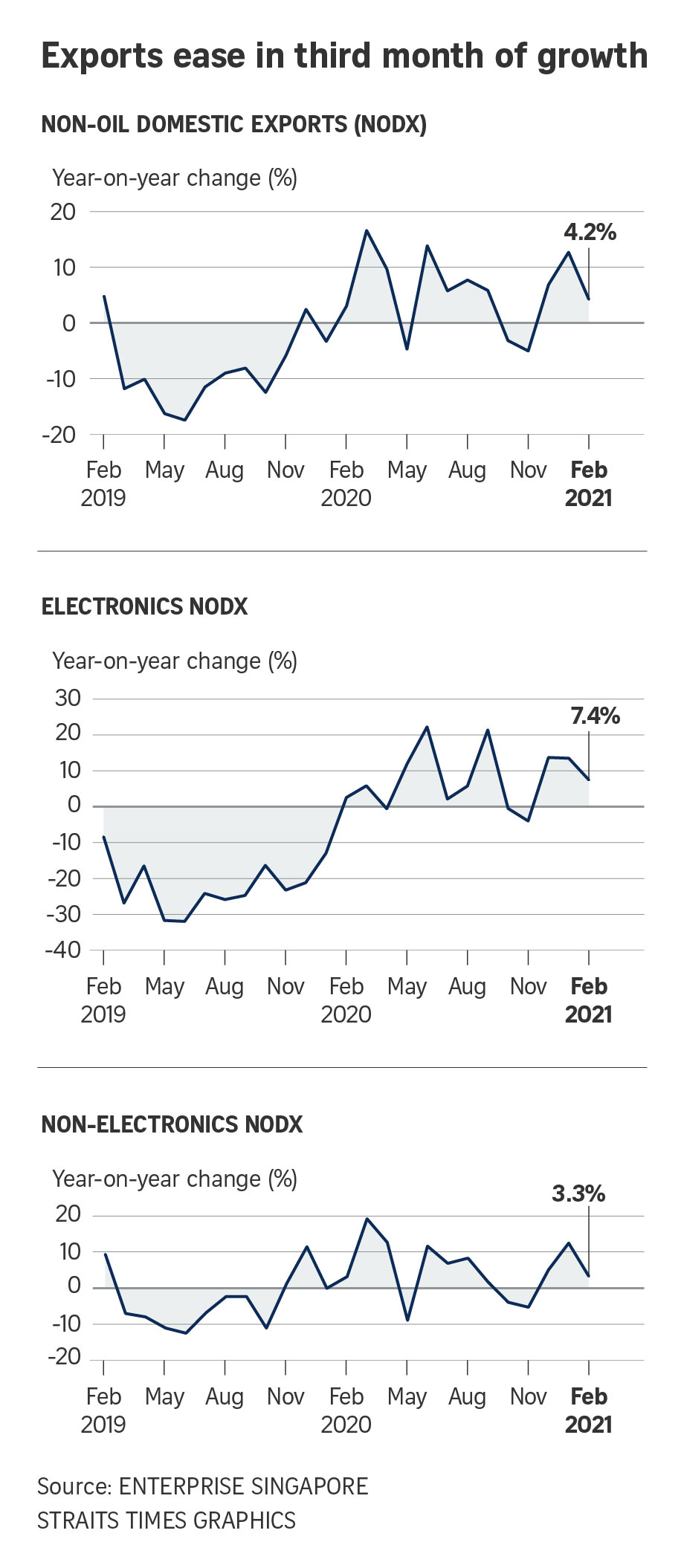Singapore non-oil domestic exports grow at slower 4.2% pace in February
Sign up now: Get ST's newsletters delivered to your inbox

Nodx expanded by 4.2 per cent last month compared with the same period last year.
ST PHOTO: JASON QUAH
Follow topic:
SINGAPORE - Singapore's non-oil domestic exports (Nodx) continued to expand, but at a slower rate in February, on the back of a rise in both electronic and non-electronic shipments, according to data out by Enterprise Singapore (ESG) on Wednesday (March 17).
Nodx rose 4.2 per cent last month compared with the same period last year, moderating from the 12.7 per cent surge in January. It is also lower than the 6.1 per cent growth forecast by analysts in a Bloomberg poll.
Electronic Nodx grew 7.4 per cent year-on-year, following the 13.5 per cent growth in January. This was due to an expansion in personal computers, which had contracted in February last year amid the global electronics downcycle, ESG noted.
Telecommunications equipment and diodes and transistors also contributed to the growth.
Meanwhile, non-electronic Nodx rose by 3.3 per cent last month, following the 12.5 per cent growth in January. Non-monetary gold, specialised machinery in line with robust global semiconductor demand, and petrochemicals contributed the most to this expansion, ESG said.
Nodx to the top 10 markets as a whole declined in February, though exports to China, South Korea, Taiwan and Hong Kong grew.
The largest contributors to the decline were the European Union 27, Japan and the United States.
But Nodx to emerging markets grew by 45.7 per cent, including areas such as Cambodia, Laos, Myanmar and Vietnam, the Caribbean and South Asia.
The moderation in momentum was not entirely unexpected given the change in Chinese New Year timings which fell in January last year but February in 2021, said Selena Ling, OCBC Bank's head of treasury research & strategy.
Looking at the more appropriate January-February average Nodx growth instead, shipments actually expanded 8.5 per cent for the first two months of this year, compared to -0.1 per cent for the same period last year, she noted.
Going into the second quarter, Nodx growth will be elevated by the low base due to the circuit breaker during April-May 2020, Ms Ling said. For the full-year, OCBC's Nodx growth forecast remains unchanged at 2 per cent, she added.
Maybank Kim Eng economists Chua Hak Bin and Lee Ju Ye said they expect Nodx growth to ease this year to around 3 per cent to 4 per cent, following a strong performance last year when exports saw limited impact from the lockdowns.
"Supply and logistics bottlenecks could dampen the export outlook for the coming quarters, including the congestion at ports and chip shortages," they said.
They also noted that container ships face longer wait times and delays at ports due to surging cargo volumes and stricter lockdowns in some countries. The turnaround time for container vessels in Singapore's port has more than doubled to five to seven days, from a maximum of two days earlier.
"Chip shortages may also disrupt the whole tech and auto supply chain, impacting electronics exports," they said.
For last month, oil domestic exports dropped by 28 per cent year on year, with lower shipments to the European Union 27, Hong Kong and Malaysia.
On a month-on-month seasonally adjusted basis, Nodx expanded by 8.2 per cent in February, following the previous month's 6.9 per cent increase. The level of Nodx reached $16.7 billion last month, higher than January's $15.4 billion, seasonally adjusted.
Year on year, total trade declined by 3.3 per cent last month, following the 1.9 per cent dip in the preceding month. Total exports declined by 2 per cent, while total imports fell by 4.6 per cent.
However, on a month-on-month seasonally adjusted basis, total trade grew by 6 per cent last month, extending the 5.7 per cent rise in January. The level of total trade reached $91.8 billion in February, higher than the previous month's $86.6 billion, seasonally adjusted.
Total exports rose by 6.3 per cent in February, while total imports grew by 5.7 per cent.


